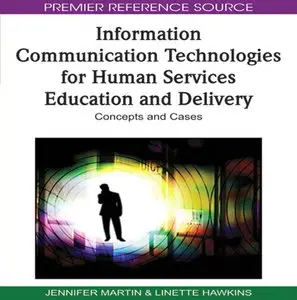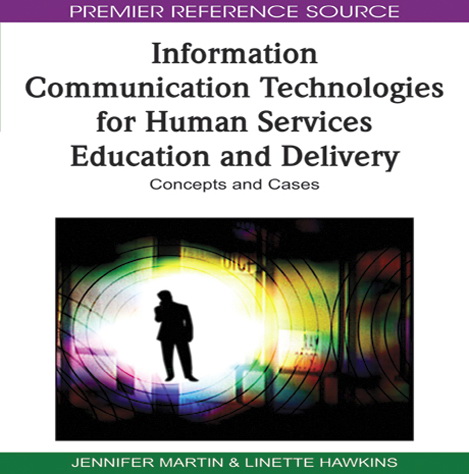Information Communication Technologies for Human Services Education and Delivery: Concepts and Cases (Premier Reference Source)By Jennifer Martin, Linette Hawkins
Publisher: Information Science Reference 2009-08-21 | 305 Pages | ISBN: 1605667358 | PDF | 3.6 MB
Publisher: Information Science Reference 2009-08-21 | 305 Pages | ISBN: 1605667358 | PDF | 3.6 MB
Information communication technologies in human services are of increasing interest and concern to health and welfare educators, managers, and practitioners due to their useful information management and teaching capabilities. Information Communication Technologies for Human Services Education and Delivery: Concepts and Cases significantly contributes to the growing area of ICT application in education and human service delivery. Containing expert international contributions, this Premier Reference Source showcases innovative practices, addresses ethical and logistic concerns, and provides relevant theoretical frameworks and the latest empirical research findings.
Table of Contents:
Section I: Information Communication Technologies and Human Services Education
This section presents theories, methods and models for developing and applying information communication technology in human services education.
Chapter I: Educating a Multidisciplinary Human Services Workforce: Using a Blended Approach
This chapter explores technological developments in the human services and the educational requirements of a skilled labor force. It is argued that learner experiences can be enhanced by adopting a blended approach that includes face- to- face and online activities. Careful planning is required that matches desired learning experiences and learner characteristics with appropriate educational design and architectures. A case study highlights the complexity of applying these in practice, as well as the importance of community building in the online environment.
Chapter II: Educational and Social Benefits of Social Network Sites: Applications to Human Services Education and Practice
This chapter offers an introduction to online social network sites, summarizing their features, uses, demographics, and trends, and presents emerging research on their social and educational potential. An accompanying case study reveals how young adults might use online social network sites to further personal and educational goals. The chapter concludes with a discussion of how such sites might be employed by human services education students, practitioners and clients.
Chapter III: Collaborative Learning: Using Group Work Concepts for Online Teaching
This chapter examines the concept of collaborative learning and its theoretical and practical foundations. The authors have trialed the use of various technologies in the human services and several case examples of online collaborative learning are provided. These case studies cover activities such as supervision and controversial issues in social work ethics. The chapter concludes with a discussion of the future directions and the challenges this poses for traditional classroom teaching.
Chapter IV: Asynchronous Online Role-Plays Using a Blended Learning Design: Integrating Theory and Practice
The focus of this chapter is on design options for asynchronous online role-plays that may assist students to integrate theory and practice and develop skills in reflexive practice. The design options discussed in this chapter adopt a “blended” learning approach where online learning is used to complement face-toface learning. Five models of online role-plays are discussed and various learning and teaching strategies canvassed to assist those teaching in the human services area to adopt and adapt these design options to meet their curriculum objectives.
Chapter V: Virtual Situated Learning Environments: Developing Inter-Professional Skills for the Human Services
This chapter explores how ICT can be used to create environments in which students engage in workrelated learning opportunities through virtual situated learning environments. These VSLEs are created digitally as real-life learning opportunities. The chapter presents an example of a VSLE used to engage students in a related field of employment relations and outlines an example of how a virtual community centre may be used to develop employability skills for students in human services.
Chapter VI: Electronic Classroom, Electronic Community: Designing eLearning Environments to Foster Virtual Social Networks and Student Learning
This chapter reports on a qualitative research project designed to explore the significance of community for students studying online. Using three fundamentally different types of online learning environments as case studies, this research explored the relationship between the constructed online learning environment and the development of learning communities or what the author hasI have termed social learning support networks.
Chapter VII: Creating and Sustaining Community in a Virtual World
This chapter provides an insight into the use of information communication technology to create and sustain community. We are currently living in an electronic age where it is easier to travel the world and stay in touch with people who live away from our face-to-face environment without the need to leave home or to meet in a real life situation than ever before. The Web is becoming a place where we encounter others in ways to get our personal, social, and professional needs met. As a result of this growing phenomenon individuals are seeking to be a part of online communities of individuals who interact and associate with one another through the Web and the use of modern technology.
Chapter VIII: Building Professional Practice Education Cultures in the Online Environment
This chapter reviews the use of online technologies in post secondary education, the use of critical reflection as a pedagogical tool and social work field education, to contextualize the experience of the Dalhousie University School of Social Work’s distance delivery field education course. Connections are developed amongst the online environment, adult education principles, and critical reflection on field education in social work, to craft an expanded message regarding transformative social work practice.
Chapter IX: Virtual Communication for Field Education Placements in a Global Context
Drawing upon the experience of students at one university in Australia who undertook international placements over a three year period, with particular attention to those engaged in group placements in Orissa, India, this chapter presents the different placement structures, the application of ICT and pedagogical factors requiring critical attention.
Section II: Information Communications Technologies and Human Services Delivery
This section presents theories, methods and models for developing and applying information communication technology in human services practice.
Chapter X: Developing Information Communication Technologies for the Human Services: Mental Health and Employment
This chapter introduces a design process for developing useful information communication technologies for the human services. The stages involved in the design process are presented in this chapter and include: user and task analysis, persona and scenario development and the establishment of measurable usability goals. A case study illustrates the application of this design process to develop a Web enabled Electronic Work Requirement Awareness Program for people recovering from mental illness seeking employment.
Chapter XI: Practical Applications of Case Management Software for Practitioners in Health and Human Services
This chapter aims to demonstrate the capabilities and practical applications of a case management software system for not-for-profit organizations- “Penelope”. Penelope is a sophisticated piece of technology that can collect and analyze information on clients, services, human resources and outcomes. The requirements for effective use of case management software are discussed including technical, management and analytical skills combined with leadership and imagination.
Chapter XII: The Role of Information and Communications Technologies in Human Rights Monitoring and Advocacy
This chapter analyses tools and techniques used to document human rights abuse. It outlines the opportunities and pitfalls associated with the use of information and communication technologies by human rights organizations, and it examines the importance of rigorous documentation to underpin human rights work. Tools developed to help grassroots organizations record usable and actionable information are contrasted with an initiative that actively involves citizens in the reporting of xenophobic attacks. The analysis shows that the tools and systems used to monitor human rights violations are essential to the effective implementation of human rights standards. It also shows, however, that new technologies can empower ordinary citizens to become directly involved in awareness building and debate about human rights abuse.
Chapter XIII: Social Shaping of Technologies for Community Development: Redeployment of Information Communication Technologies among the Kelabit in Bario of the Kelabit Highlands
Using electronic-Bario (e-Bario) project in the Kelabit Highlands of Sarawak in East Malaysia, this chapter explores how the introduction of information communication technologies (ICT) as developmental tools have been mediated and reconfigured by webs of social relations and the intricate interplay of social, political and cultural conditions specific to different social and technical settings. One crucial factor conditioning the effects of the project has been the Kelabit’s own desire for, and expectations of, “development” and “progress.” This is a quest which ties in closely with two fundamental Kelabit concepts: doo-ness and iyuk. As a result, the social and economic effects of ICT have unfolded through countless open-ended strategic and everyday decisions made by the Kelabit themselves, who actively consume, apply and make use of objects, ideas and services in the Highlands.
Chapter XIV: Social Policy and Information Communication Technologies
This chapter examines the contribution of information communication technology (ICT) to the operation of social and public policy. The governmentality analytic is introduced as a way in which to highlight how ICT is used by the state in governing populations. The chapter identifies four ways ICTs relate to social and public policy. First, social policy can be a response to ICT innovation and use. Second, ICT is used to implement and administer social policy. Third, ICT is used to develop and evaluate social policy. Fourth, the use of ICT can shape the very nature and substance of social policy. The chapter illustrates these theoretical and conceptual approaches by examining the extensive and innovative use of ICT in Australia’s national income security agency, Centrelink
Chapter XV: Knowledge Sharing Online: For Health Promotion and Community Education: e-Mavenism
The aim of this chapter is to explore the utility of online knowledge sharing for the health and human services. Experiences in marketing are used as a basis for the development of three broad and interrelated theoretical concepts—the diffusion of innovations, viral marketing, and online word of mouth advertising—as well as several other influential factors to explain online knowledge sharing. Three major elements that stimulate online knowledge sharing are distilled from these theoretical perspectives including internal factors such as altruism, online social network size, and topic salience. This chapter uses these elements to propose a model of e-Mavenism which explains the cognitive processes that lead to online knowledge sharing behavior. Based on the e-Mavenism model, several strategies are suggested for online health promotion and community education.
Afterword





